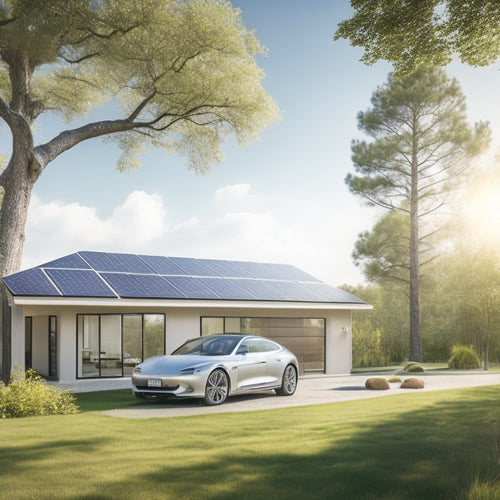
7 Sustainable Urban Mobility Solutions to Adopt Now
Share
As you work towards creating a more sustainable urban transportation system, consider adopting seven innovative solutions. Implement electric bus rapid transit systems to reduce emissions and operating costs. Leverage smart traffic management infrastructure, including real-time monitoring and intelligent signal control systems, to optimize traffic flow and reduce congestion. Autonomous shuttle services and green light best speed advisory systems can also enhance the commuter experience. Additionally, promote bike-sharing and pedestrianization, expand electric vehicle charging networks, and utilize data-driven urban planning tools to optimize urban mobility. By embracing these solutions, you'll be well on your way to transforming your city's transportation landscape - and there's still more to discover.
Key Takeaways
• Implement Electric Bus Rapid Transit Systems to reduce greenhouse gas emissions and operating costs, and enhance passenger-centric transportation.
• Leverage Smart Traffic Management Infrastructure, including real-time monitoring and intelligent signal control, to reduce congestion and optimize traffic flow.
• Launch Autonomous Shuttle Services that prioritize eco-friendliness, safety, and social inclusivity to provide efficient transportation for all commuters.
• Foster a cultural shift towards pedestrian-friendly urban landscapes by promoting Bike-Sharing and Pedestrianization, and enhancing bike safety with dedicated lanes and intelligent traffic management.
• Establish extensive Electric Vehicle Charging Networks with seamless, accessible, and affordable charging experiences to support widespread EV adoption.
Electric Bus Rapid Transit Systems
As you explore sustainable urban mobility solutions, electric bus rapid transit (BRT) systems emerge as a promising approach, offering a cleaner, more efficient, and cost-effective alternative to traditional fossil-fuel-based transportation systems. By integrating electric buses into your transportation network, you can greatly reduce greenhouse gas emissions and operating costs.
To maximize the benefits of electric BRT systems, you'll want to focus on bus fleet expansion and route optimization. Expanding your bus fleet with electric vehicles will enable you to increase the frequency and coverage of your BRT system, making it a more appealing option for commuters.
Additionally, optimizing routes using advanced analytics and data insights will help you streamline operations, reduce congestion, and improve travel times. By leveraging these strategies, you can create a more efficient, sustainable, and passenger-centric transportation system that sets a new standard for urban mobility.
As you move forward with electric BRT systems, you'll be poised to revolutionize the way people move within and between cities, creating a cleaner, healthier, and more livable urban environment.
Smart Traffic Management Infrastructure
You're likely familiar with the frustration of rush-hour traffic, but what if you could navigate through congested streets with ease?
Smart traffic management infrastructure makes this possible by leveraging real-time traffic monitoring, intelligent signal control systems, and optimized traffic routing to minimize congestion and reduce travel times.
Real-time Traffic Monitoring
Implementing real-time traffic monitoring systems enables cities to dynamically adjust traffic signal timings, optimizing traffic flow and reducing congestion by up to 25% during peak hours.
With real-time data, you'll gain a deeper understanding of traffic patterns, allowing you to identify areas of improvement and make data-driven decisions.
By leveraging advanced sensors, cameras, and IoT devices, you'll have a bird's eye view of traffic conditions, empowering you to respond swiftly to incidents and minimize disruptions.
For instance, if a traffic accident occurs, real-time monitoring enables you to quickly divert traffic, reducing congestion and minimizing the impact on commuters.
By analyzing traffic patterns, you'll uncover hidden inefficiencies and optimize traffic signal timings to reduce congestion, air pollution, and travel times.
You'll be able to respond swiftly to incidents, ensuring a smoother, more efficient commute for everyone.
With real-time traffic monitoring, you'll be at the forefront of smart traffic management, paving the way for a more sustainable, efficient, and connected urban mobility future.
Intelligent Signal Control Systems
By integrating intelligent signal control systems into your urban infrastructure, you can harness the potential of dynamically adjusting traffic signal timings to optimize traffic flow, reduce congestion, and minimize travel times. This cutting-edge technology analyzes real-time traffic patterns to identify areas of congestion and adjusts signal timings accordingly.
For instance, during peak hours, the system can extend green light durations to prioritize main roads, ensuring a smoother urban flow. By doing so, you can alleviate congestion by up to 30% and decrease travel times by an average of 20%.
Moreover, intelligent signal control systems can adapt to changing traffic patterns, such as unexpected road closures or construction. This flexibility enables your city to respond quickly to emerging challenges, ensuring that traffic continues to flow efficiently.
Optimized Traffic Routing
With advanced traffic routing algorithms and real-time traffic data, your city can dynamically optimize traffic flow, re-routing vehicles around congested areas and reducing travel times by up to 25%. This smart traffic management infrastructure enables you to make data-driven decisions, ensuring a smoother and more efficient commute for citizens.
Route optimization is an essential aspect of optimized traffic routing, as it analyzes traffic patterns and adjusts routes in real-time to minimize congestion. By leveraging traffic analytics, you can identify areas of improvement and implement targeted solutions.
Here's a breakdown of the benefits of optimized traffic routing:
| Solution | Benefit | Impact |
|---|---|---|
| Real-time Traffic Data | Accurate traffic insights | 20% reduction in congestion |
| Route Optimization | Dynamic route adjustments | 15% decrease in travel time |
| Traffic Analytics | Data-driven decision making | 30% increase in traffic efficiency |
| Smart Traffic Signals | Coordinated traffic flow | 25% reduction in travel time |
| Integrated Transit Systems | Seamless multi-mode transport | 40% increase in public transport usage |
Autonomous Shuttle Services Launch
As you step into the futuristic urban landscape, a fleet of self-driving shuttles is poised to revolutionize the way you navigate city streets. These autonomous vehicles are designed to provide efficient, eco-friendly transportation, reducing congestion and emissions. But before they hit the roads, it's important to address Public Perception. Will you feel comfortable stepping into a driverless shuttle? The answer lies in implementing robust Safety Protocols.
Advanced sensors and AI-powered systems will guarantee your safety, while real-time monitoring and emergency response plans will mitigate any risks.
As autonomous shuttle services launch, you'll experience a seamless travel experience, with optimized routes and reduced travel times. With the ability to seamlessly integrate with public transit systems, these shuttles will become an essential part of your daily commute. Additionally, they'll provide equal access to transportation for the elderly and disabled, promoting social inclusivity.
As you ride into the future, you'll witness a significant reduction in traffic accidents, pollution, and urban chaos. Get ready to experience the transformative power of autonomous shuttle services, redefining the urban mobility landscape.
Green Light Optimal Speed Advisory
As you navigate through the urban landscape, you're about to experience a seamless driving experience courtesy of Green Light Best Speed Advisory. This innovative system provides you with real-time traffic updates, ensuring you're always in the know about the road ahead.
Real-Time Traffic Updates
You can optimize your commute by leveraging real-time traffic updates, which provide Green Light Best Speed Advisory, a cutting-edge technology that synchronizes your speed with traffic signals to minimize stops and reduce congestion.
By having access to real-time traffic data, you can anticipate traffic patterns and adjust your speed accordingly, ensuring a smoother journey. This technology takes into account current traffic conditions, commuter behavior, and traffic signal timings to provide personalized speed recommendations.
By optimizing your speed, you can reduce the time spent at traffic lights, decreasing congestion and emissions. Real-time traffic updates also enable you to make informed decisions about your route, helping you avoid congested areas and reduce travel time.
Optimized Traffic Signal Control
With optimized traffic signal control, your vehicle can receive personalized speed guidance, ensuring you hit every green light in sequence, thereby minimizing stops and reducing congestion. This innovative technology utilizes advanced Traffic Flow Analytics to optimize signal timing, ensuring a smoother, more efficient commute.
By analyzing real-time traffic data, optimized traffic signal control systems can adjust signal timings to reduce congestion and minimize stops.
Through Signal Timing Optimization, traffic signals can be synchronized to optimize traffic flow, reducing travel times and decreasing emissions. This intelligent system can even adjust to changing traffic conditions, adapting to unexpected events like accidents or road closures.
Smarter Driver Decisions
By receiving real-time speed guidance, drivers can make informed decisions to optimize their speed and arrive at the next intersection just as the light turns green, minimizing stops and reducing congestion. This futuristic approach, known as Green Light Best Speed Advisory, empowers you to take control of your journey.
By leveraging advanced data analytics and IoT sensors, you'll receive personalized speed recommendations, ensuring a smoother, more efficient ride. This innovative solution not only reduces travel time but also decreases fuel consumption and emissions, making it a win-win for you and the environment.
To further encourage responsible driving habits, cities can implement Driver Education programs, focusing on the benefits of eco-friendly driving practices. Additionally, Incentivization Strategies, such as rewards for green driving or low-emission zones, can motivate you to adopt sustainable habits.
Bike-Sharing and Pedestrianization
Cities worldwide are embracing bike-sharing systems, which not only reduce reliance on personal vehicles but also foster a cultural shift toward pedestrian-friendly urban landscapes.
As you navigate these revamped urban spaces, you'll notice a heightened emphasis on bike safety. Dedicated bike lanes, cleverly designed intersections, and intelligent traffic management systems all converge to minimize the risk of accidents. This harmonious coexistence of cyclists, pedestrians, and motorists is a hallmark of forward-thinking urban placemaking.
By reclaiming streets from cars and allocating more space for pedestrians and cyclists, cities are being reshaped into vibrant hubs of community engagement and social interaction. You'll find yourself immersed in a thriving ecosystem where local businesses, public art installations, and green spaces blend seamlessly together.
As bike-sharing systems continue to evolve, you can expect to see even more innovative solutions that prioritize user experience, convenience, and environmental sustainability. By embracing this shift, you're not only reducing your carbon footprint but also contributing to a more livable, people-centric urban environment.
Electric Vehicle Charging Networks
As you plug into the electric vehicle (EV) revolution, you'll find that seamless charging experiences rely on the proliferation of extensive charging networks. The widespread adoption of EVs hinges on the availability of convenient, reliable, and accessible charging infrastructure.
You'll need to prioritize the Vehicle Accessibility aspect, ensuring that charging stations are strategically located, easily accessible, and equipped with user-friendly interfaces.
However, Charging Inequality is an important concern that must be addressed. Uneven distribution of charging points in urban and rural areas can create disparities in access to EV ownership. It's essential to implement policies and incentives that promote the development of charging networks in underserved communities.
You should also expect to see advancements in fast-charging technology, enabling you to replenish your battery to 80% in under 30 minutes. As the EV landscape continues to evolve, you'll witness the emergence of innovative business models, such as subscription-based charging services, that prioritize convenience and affordability.
Data-Driven Urban Planning Tools
You'll leverage advanced data analytics and artificial intelligence to optimize urban mobility, relying on data-driven urban planning tools that can process vast amounts of data in real-time to predict traffic patterns, identify infrastructure bottlenecks, and inform sustainable transportation strategies.
By harnessing the power of Urban Analytics, you'll gain a deeper understanding of your city's dynamics, allowing you to create data-informed policies that drive meaningful change.
Through City Simulation, you'll be able to model and test various urban planning scenarios, evaluating the impact of different interventions on your city's mobility ecosystem. This iterative process enables you to refine your strategies, minimizing unintended consequences and maximizing the effectiveness of your sustainable mobility initiatives.
As you continue to refine your data-driven approach, you'll uncover hidden patterns, identify emerging trends, and reveal new opportunities for growth and development.
Frequently Asked Questions
How Can We Ensure Equitable Access to Sustainable Mobility Solutions?
As you navigate urban landscapes, you'll realize that addressing mobility inequality is essential; by integrating inclusive urban planning, you can guarantee equal access to sustainable mobility solutions, bridging gaps and fostering a more equitable future.
What Are the Costs Associated With Implementing Smart Traffic Systems?
'As you implement smart traffic systems, you'll face costs from system integration, financial models, and infrastructure upgrades, plus ongoing maintenance costs, all while overcoming technological barriers that'll test your planning and budgeting skills.'
Can Autonomous Shuttles Operate in Areas With Heavy Pedestrian Traffic?
As you navigate the bustling streets, you wonder if autonomous shuttles can harmoniously coexist with pedestrians. The answer lies in strategic sensor placement, intelligent route optimization, and pedestrian flow analysis, ensuring seamless safety protocols that protect both humans and machines.
How Do Green Light Optimal Speed Advisories Impact Fuel Efficiency?
As you navigate roads, green light ideal speed advisories greatly enhance fuel savings, optimizing traffic flow by up to 15%. By syncing with real-time traffic signals, you'll cruise through intersections, reducing stops and starts that guzzle fuel.
Are There Incentives for Cities to Invest in Electric Vehicle Charging Networks?
As you consider investing in electric vehicle charging networks, you'll find incentives like utility partnerships and government subsidies can greatly offset costs, making it a more viable and attractive option for cities to adopt.
Related Posts
-

Waterproofing Solar Panels for Vehicles: A Step-by-Step Guide
When waterproofing solar panels for your vehicle, start by evaluating your energy requirements and selecting the righ...
-

Why Invest in Solar Car Battery Chargers Online?
By investing in a solar car battery charger online, you're not only reducing your reliance on fossil fuels but also o...
-

Why Electric Motorcycles Fail at Long-Distance Touring
You're likely familiar with the excitement of hitting the open road on an electric motorcycle, but you're also smart ...


